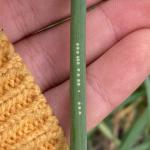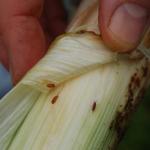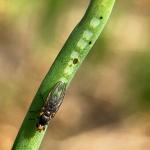Leafminer, Allium
(Phytomyza gymnostoma)
Allium leafminer is an invasive fly pest that was first detected in Pennsylvania in 2015, and has since spread to parts of western New York, Connecticut, and Massachusetts. This pest affects all allium crops and can result in decreased marketability and total crop loss. The first signs of allium leafminer are white spots in straight rows on leaf tissue, indicating oviposition (egg-laying).
Identification
Adults are grey or black flies, measuring about 3 mm long. They have a yellow-orange spot on the top of the head and yellow spots on the joints of the legs. Larvae are white to yellow headless maggots that are up to 8 mm long at the final instar. Pupa are small and brown, measuring 3.5 mm long. Allium leafminer eggs are white, 0.5 mm long and curved slightly. Adult flies feed on leaves, leaving distinctive straight lines of small white spots. Females then turn around and lay eggs in some of those feeding scars.
Life Cycle
Allium leafminer overwinters as pupae in allium plant tissue and surrounding soils, emerging as adult flies the following spring over a 5- to 7-week period beginning in early spring. A model developed by Penn State Extension suggest that emergence starts at 350 GDD base 1⁰C. This coincides roughly with start of forsythia and daffodil bloom and occurs during the first two weeks of April in most locations in MA. Female flies lay eggs within leaf tissue, leaving behind characteristic oviposition scars in neat rows along the leaf. Larvae hatch and feed within the leaf tissue, mining downwards towards the base of the plant. Larvae pupate either within the allium tissue, moving with the harvested crop or remaining in residues in the field, or in the surrounding soil. Pupae remain dormant during the summer and emerge as adults in late August or early September for a second flight lasting about 5- to 7-weeks.
Crop Injury
Allium leafminer activity can be identified by the distinct white feeding and oviposition marks made in a straight line on the leaf surface, typically towards the tips of leaf blades. Feeding by larvae forms straight, vertical tunnels running down towards the base of the plant. (There are generalist leafminer species that cause irregular, wiggly tunneling; these leafminers generally do not cause extensive damage in any vegetable crops, including alliums). Feeding by larvae can also cause leaves to become distorted and wavy, affecting plant growth and yield. Larval feeding damage can serve as entryways for bacterial and fungal pathogens, which can lead to bulb rot in the field or in storage. The physical presence of larvae and/or pupae within alliums can also cause crops to be unmarketable.
Garlic has been found to be less attractive than other alliums. Fall leeks are often the most damaged crop because they are the only allium crop remaining in fields during the fall flight.
Monitoring & Thresholds
Plants are considered heavily infested when there are more than 20 larvae or pupae on one plant. Early detection and monitoring are vital to control of this pest. Scout overwintered or spring allium crops for oviposition marks beginning in early April and fall leek crops starting in early September. If a significant number of larvae or pupae are found in a harvested spring or fall crop, the following generation will emerge from that affected field and infest nearby alliums first. For example, in spring we often see the first signs of allium leafminer in overwintered onions or perennial chives, or in alliums planted near to last year’s infested leeks. Adult flies can be monitored using yellow sticky cards.
Cultural Controls & Prevention
- If transplants are growing during the spring flight, inspect for oviposition marks before planting out in the field.
- Cover allium crops from March through mid-May, and again in mid-August through September to prevent egg laying while adults are active. Insect netting will provide protection without trapping heat.
- Delay planting allium crops until after mid-May to avoid the period when adults are active and laying eggs.
- Delay garlic planting until late October, after the second flight is complete.
- Rotate allium crops with non-alliums, both between and within seasons. Allium leafminer adults are strong fliers and can move relatively long distances, so rotating further away is better.
- Till under infested crop residues promptly after harvest to kill larvae and pupae and eliminate overwintering sites.
- Use reflective plastic mulch in addition to spraying insecticides. Research from Cornell Cooperative Extension has shown that growing alliums on reflective plastic mulch and applying insecticides (see below) reduced allium leafminer infestation beyond the level achieved by just spraying. Unsprayed alliums on reflective mulch had high levels of infestation.
Chemical Controls
Organic control options include spinosad, azadirachtin, insecticidal soaps, and oils. Spinosad works primarily by ingestion and has some translaminar activity, meaning it will move somewhat into the leaf after it has been applied to the leaf surface. The larvae need to consume the leaf material containing spinosad in order to be killed. Azadirachtin works on contact only and so needs to be targeted at flying adults. Research from Cornell Cooperative Extension in 2018 and 2019 found that Entrust (spinosad) at the 6 oz/acre rate and M-Pede (potassium salts of fatty acids, an insecticidal soap product) at the 1%-1.5% v/v solution rate effectively controlled allium leafminer if applied 2 times, 2-4 weeks after first detecting allium leafminer emergence.
Synthetic control options include foliar applications of dinotefuran, cyantraniliprole, spinetoram, and lambda-cyhalothrin. Cyantraniliprole and spinetoram are also commonly used in leeks for control of onion thrips; growers using these materials to control thrips should check maximum annual application rates before using to control allium leafminer. In a review conducted by researchers in Pennsylvania and New York in 2018 and 2019, these three insecticides reduced damage by 89% and eradicated up to 95% of ALM.
Crops that are affected by this insect:
All allium crops, as well as wild allium species, can be affected by allium leafminer.
The Center for Agriculture, Food and the Environment and UMass Extension are equal opportunity providers and employers, United States Department of Agriculture cooperating. Contact your local Extension office for information on disability accommodations. Contact the State Center Director’s Office if you have concerns related to discrimination, 413-545-4800 or see ag.umass.edu/civil-rights-information.


